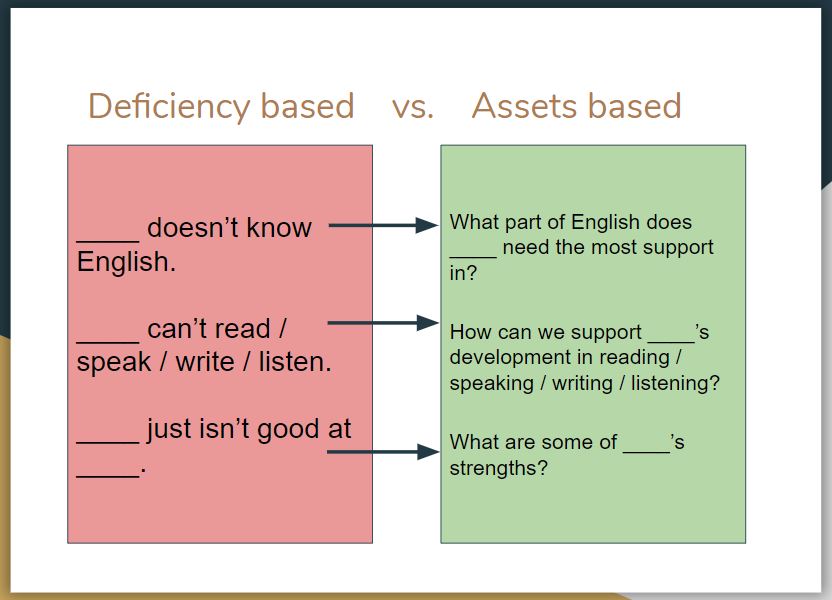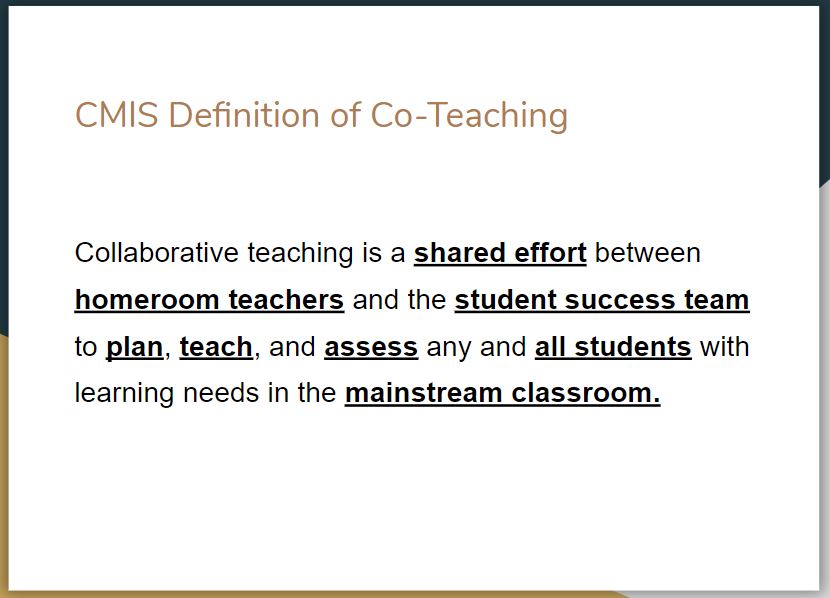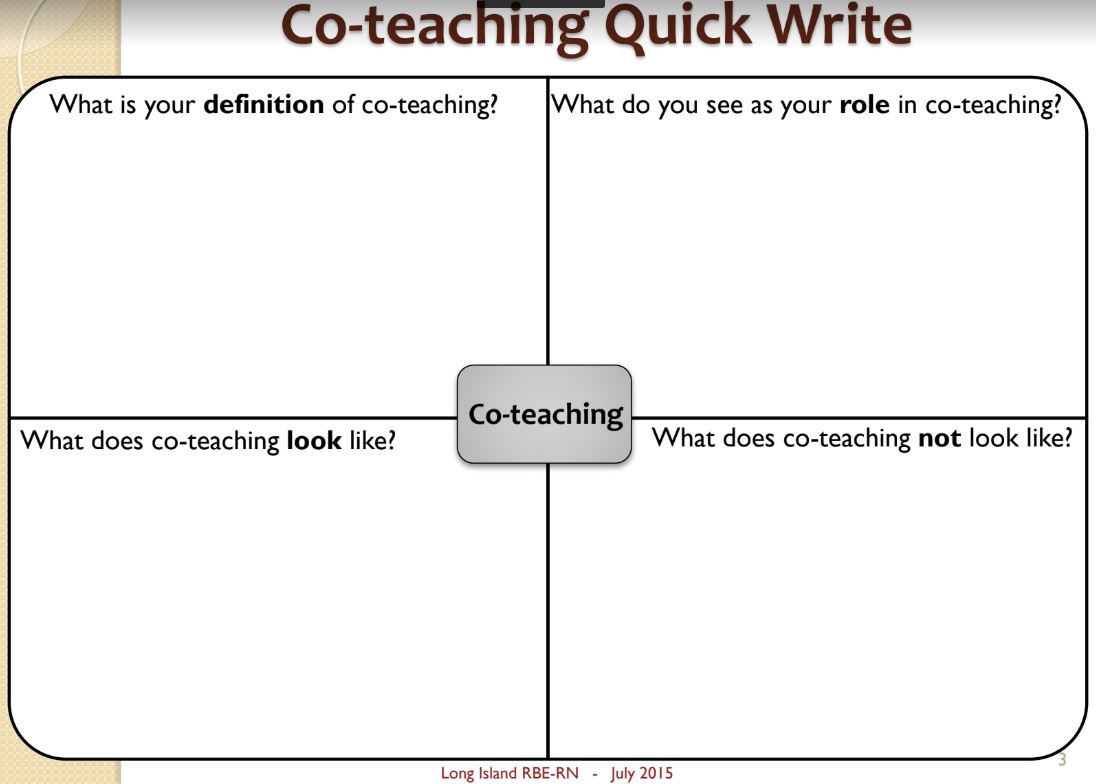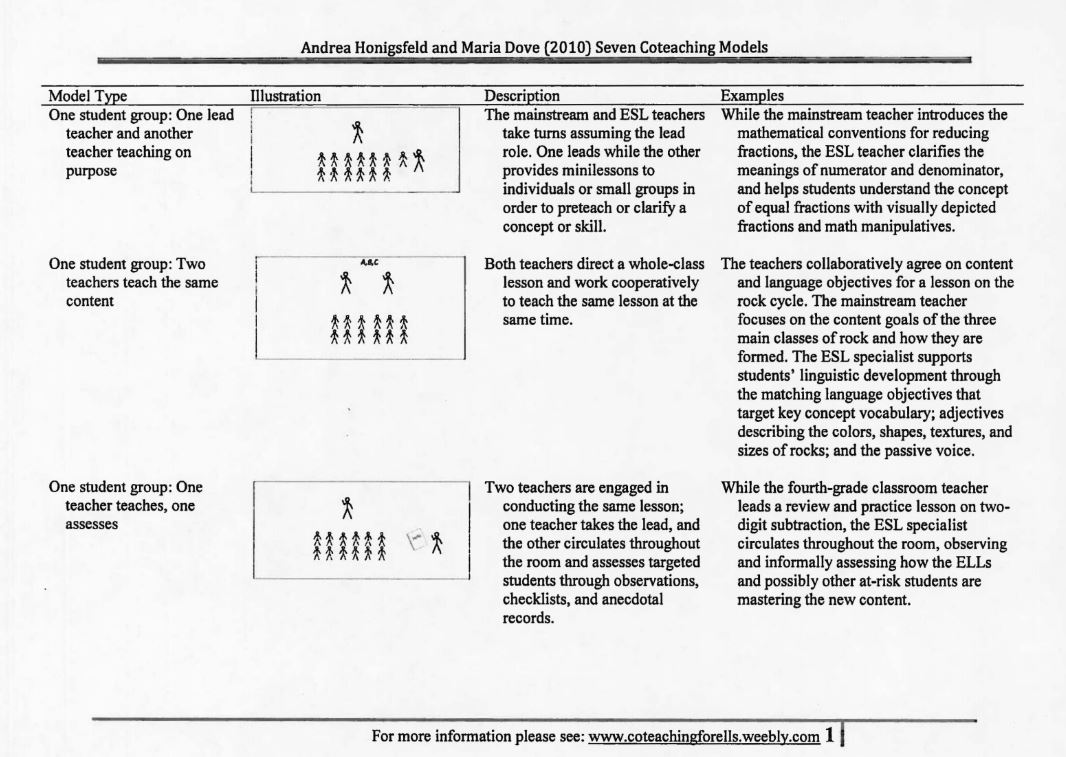My First Week of Co-Teaching
This week kicked off my first week of actual Co-Teaching! Hooray! I survived! I’m still employed! I still love my job!
In all seriousness, over the past year I’ve been researching, reaching out to professionals, reading a lot, and meeting with administration to set the stage for a productive Co-Teaching school culture. I came in with a plan, and this week I not only executed, but took time to reflect so I can improve for next year (already!). I can’t thank my fabulous twitter PLN enough; @Toppel_ELD, @TanELLClassroom, @ReadySetCoTeach, @Andrea honigsfel, @specsol, @Larryferlazzo, @CBTennyson, @MsSalvac, and everyone active in our fabulous #ELLchat for getting me started! I couldn’t have done this without your amazing help.
This blog post is narrative, part informative, but also part reflection. I came into the year with a plan, but I also didn’t want to micro-manage my interactions with teachers. After all, teaching is a profession where we work with people. Not everything runs smoothly, so I felt it necessary to get organized on a basic level and tackle the nitty gritty details as the week progresses. Over the course of this week, I realized that a lot of what I planned worked really well for myself and teachers, but there were a few things that I wish I would have done a little differently.
Definitely do: Make your role known
One thing I’m so glad that I organized was a brief presentation about Co-Teaching. It contained the basic definition of what Co-Teaching is, but also the definition I developed with my administrative staff. Having everyone take part in what a collaborative teaching environment looks like gave us a more united front, which helped validate what we are trying to accomplish. I didn’t review every Co-Teaching model or the components of Co-Planning as to not overwhelm teachers new to having a teaching partner (which was essentially the entire staff). Since I’m the only ELD Co-Teacher for the 12 elementary staff, tackling what it would look like for each teacher team during our first Co-Planning session would be a better time to delve into the specifics. My feedback afterwards was mostly positive; it was the perfect amount of information for new teachers, but returning staff wanted to know more details.
I started creating it in May before the school year was over and worked on it piece by piece over the summer (adding and editing information as I learned more). Sometimes I slept on it for a week then came back to it with fresh eyes and a fresh perspective. I met with my administration over the course of the year as I created it, too, so they can provide input on what to add / edit / omit. It’s all about a balance of being specific enough to make your point clear, but also general enough as to know overload teachers with too much input. At the start of the year, there’s usually loads of the latter, so be sure to adjust accordingly.
Definitely do: Give a Co-Teaching Quick Write
Maria Dove and Andrea Honigsfeld suggested providing a Co-Teaching Quick Write at the start of the year to gauge everyone’s background knowledge of what collaborative instruction looks like, how it’s organized, and what it isn’t. It was also a great ice breaker activity to get our meeting started. Teachers broke off into their teacher teams (specialists also were included in this!) to complete the handout. Afterwards, teachers shared some of the points with the whole group. Later, I compiled all of the information into a word cloud that I shared with teachers so I can pinpoint consistent language and ideas.
One piece of feedback I received was that I could have outlined the purpose of the Quick Write a bit more thoroughly at the start of the meeting. Some teachers weren’t very sure why they were doing it and what would be done with it afterwards, so I’ll be sure to incorporate these points in the future.
Having everyone take part in what a collaborative teaching environment looks like gave us a more united front.
Definitely do: Start Co-Planning
One of my goals for the first week was to get the common planning times for teachers so I can get involved with Co-Planning right away. It’s always difficult to change up routines in the middle of the year, so starting the first week with a (mostly) set schedule was at the front of my to-do list. I managed to meet with all six grades during week one! We didn’t delve right into Co-Planning lessons, though. Instead I provided a laminated list of Co-Teaching models as well as an adapted menu similar to John Nordmeyer’s Collaborative Teaching Menu to use a reference for “on the spot collaboration”. Teachers really appreciated the baby steps that I have been taking to get ourselves used to this process. It’s not only new to them, but new to me, too!
Now that I have my Co-Planning schedule completed, I can build my Co-Teaching schedule around the times I plan. While I’m involved in everyone’s planning meetings, I will not be Co-Teaching with every teacher, but instead teaching with teachers I a.) have a positive working relationship with and b.) have the need in their class. We’ll see how the schedule plays out in the coming weeks as it’s already filling up quickly!
Probably wait on: Co-Teaching
While I appreciated that some teachers wanted to jump into Co-Teaching right away, I expressed that Co-Teaching can wait until at least the second week of school. Depending on your comfort level with your Co-Teacher (especially if both of you have Co-Taught before) you could jump into this on day one. In my case, more than half of the elementary teachers were brand new and none of them have had experience Co-Teaching (including myself!), so I wanted to take it slow and ease into collaborative practice. Co-Planning was a great first step!
We’ll start Co-Teaching once a week and gradually increase frequency as we all become comfortable with the new dynamic. I want to make sure that we do this right rather than jump into anything too intense from the get-go. Also, teachers need their space to get settled into their new classrooms and environment. Ideally, once we establish a positive working relationship and gain more experience, we can start Co-Teaching earlier in the school year.
Should do: Help model classroom routines
After reflecting this week on my presence in classrooms, I thought that a great way to ease in to Co-Teaching would be to model lessons about classroom routines together. It’s low stress, low prep, and non-academic so planning and teaching would be an easy way to get used to Co-Teaching models. Not only would teachers become more used to two people teaching at the same time, but the students would also get used to having two teachers in the room as well.
There are plenty of opportunities to model classroom routines and expectations. A few colleagues use “Responsive Classroom” and “Morning Meeting” into their daily schedule. Working with another teacher during these lessons is a great way to model examples and non-examples of greeting each other and playing games. When modeling reading / writing stamina, a second teacher can fill in an anchor chart while another teacher models expectations. It’s also helpful to have another set of eyes in the classroom to formatively assess which students have more stamina than others. I’m already in classrooms helping with pre-assessments, which gives teachers another set of eyes to interpret and record assessment data at the start of the year.
Definitely do: Create collaborative goals
I adapted a form by @ReadySetCoteach the outlines three variations of collaborative goals: Co-Teaching, Professional, and Student goals. I also notated which goals we considered short term (being accomplished in three weeks or less) and long term (exceeding three weeks). I sent an editable Google Doc to teacher teams outlining goals that we discussed during our first Co-Planning session for teachers to review, edit, and comment on (plus I’m making an attempt to go 100% paperless this year). We’re starting with short term goals like establishing Co-Planning routines and Co-Teaching our first lesson together. This is also a great way to keep me organized and focused on what we’re working on together with students and our own professional practice.
With one teacher team, we made a short term goal about using DRA pre-assessment data to guide our future instruction for the first reading unit. Using that assessment data, we can create a long term reading goal for our students. These goals helped us focus our first weeks of collaborative instruction!
I started using this template, adapted from a form by @ReadySetCoteach, to make collaborative goals for the staff that I Co-Teach with.
~~~~~~~~~~~~~~~~~~~~~~~~~~~~~~~~
I’m SO excited to jump into Co-Teaching in the coming weeks! All of this research has really paid off, and I’m looking forward to working with my colleagues this year to not only help our students grow, but to improve our professional practice as well.










Such an awesome and productive first week! What a great way to begin the new school year. I felt like I was right there with you, Justin.
I can’t wait to hear more! Sounds like a lot of good things will be happening for your students this year!
You’ve made a strong start, Justin! Thanks for the comprehensive reflection!
What a great article, Justin. I particularly like the definitely do, should do, probably do! It’s such a nice framework of thinking about our role. It’s a realllllly trick task of managing adult professional relationships. It’s an art that I keep on refining. I always go back to supporting the emotional needs of the teacher FIRST, which then gives me a little more room to work with all students. Trust above all!
PS. Your writing is FANTASTIC!
Your blog bursts with energy, resources and sincere advice for others! Thank you for sharing your experiences, I will include your blog address in my forthcoming book with your permission so readers could follow your journey! Best wishes
Your blog bursts with energy, resources and sincere advice for others! Thank you for sharing your experiences, I will include your blog address in my forthcoming book with your permission so readers could follow your journey! Best wishes
Thanks for your super practical, honest reflections on your first week of co-teaching (last year). I’m sure the start of this year was great, too. I will be sharing your blog with many other co-teachers in the coming weeks. THANK YOU!